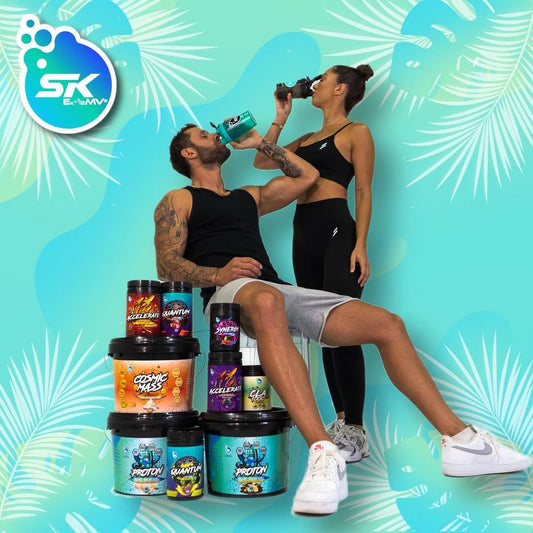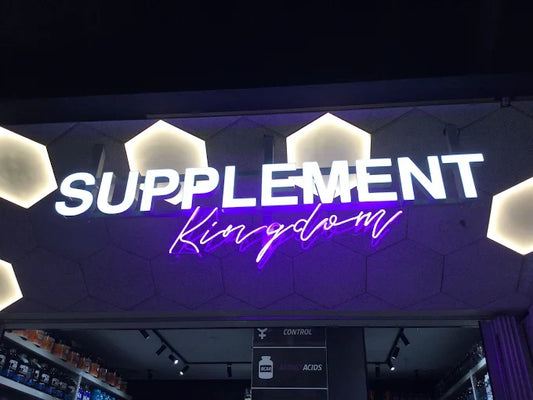How to Read Supplement Labels Like a Pro (2025 Australian Guide)

How to Read Supplement Labels Like a Pro (2025 Australian Guide)
Updated June 2025 · ~2,000 words · Perfect for anyone Googling “honest supplement advice” or “how to read a supplement label Australia.”
Introduction: Knowledge Is Your Strongest Supplement
Whether you’re a seasoned bodybuilder scanning for the next anabolic edge or a beginner staring blankly at a wall of protein tubs, one truth unites us all: the label never lies—but it doesn’t always tell the whole story, either. In Australia, every sports-nutrition product must comply with Food Standards Australia New Zealand (FSANZ) regulations. Great! Yet loopholes, jargon, and marketing spin still leave shoppers confused. This guide decodes every panel, number, logo, and HSR so you can shop with absolute confidence—online or in-store at Supplement Kingdom.
Section 1 · The Legal Framework (FSANZ 1.2.1 & 1.2.7)
First, the non-negotiables. Under Standard 1.2.1, a supplement must list:
- Ingredients in descending order by weight
- Nutrition Information Panel (NIP) with per-serve and per-100 g metrics
- Allergen declarations (e.g., Contains milk and soy)
Standard 1.2.7 then governs health claims. For example, “supports muscle growth” requires scientific substantiation—a company can’t claim magic from fairy dust. Familiarise yourself with these two standards and you already outrank 90 % of marketers.
External resource: Download the full code at foodstandards.gov.au.
Section 2 · Anatomy of a Supplement Label
| Panel | What It Tells You | Pro-Tips |
|---|---|---|
| Serving Size | How much powder equals “one scoop” (often 30 g) | Heavier scoop ≠ better value. Compare cost per 10 g protein. |
| Protein-by-Weight (PBW) | % of protein in the product (e.g., 78 %) | Target ≥75 % for isolates; ≥65 % for concentrates. |
| Leucine per Serve | Anabolic trigger AA (≥2.5 g ideal) | If not listed, scan the ingredient list or ask staff. |
| Active Ingredients | Caffeine, beta-alanine, creatine, etc. | Cross-check doses with evidence-based ranges. |
| Sweeteners & Colours | Sucralose, stevia, beetroot red, etc. | Natural flavours often cost more but reduce artificial load. |
| Allergens | Milk, soy, gluten, tree-nuts | Look for “manufactured on equipment that also processes…” disclaimers. |
Need an even quicker cheat sheet? Grab Supplement Kingdom’s free Label-Reading PDF at checkout—yours with any in-store purchase.
Section 3 · The Proprietary Blend Problem
Ever see “Performance Matrix 7 g (Citrulline, Beta-Alanine, Taurine, Deer Antler Extract…)”? That’s a proprietary blend: several ingredients locked inside one undisclosed figure. It lets brands hide tiny, ineffective doses while leaning on flashy ingredient names.
Why Transparency Wins
- Evidence-based dosing: You can verify each dose against clinical research (e.g., 6–8 g L-citrulline malate).
- Safety: Caffeine overdose is real. Transparent labels prevent accidental stim stacking.
- Value: You know exactly what you’re paying for—no expensive “filler.”
Supplement Kingdom policy: If a product hides behind blends, staff flag it and suggest transparent alternatives. That’s our No BS Promise.
Section 4 · Step-by-Step: Decoding a Real Pre-Workout Label
- Serving size: 12 g (≈1 scoop)
- Caffeine: 250 mg → within safe 3–6 mg/kg for most 70-kg athletes.
- L-Citrulline Malate: 4 g → below optimal 6–8 g → consider 1.5 scoops or a higher-dose product.
- Beta-Alanine: 2 g → short of clinical 3.2–6.4 g/day → tolerate the tingles, but you’ll need multiple servings.
- Flavour system: Natural pineapple, sucralose → great taste but synthetic sweetener.
- Allergens: None → safe for lactose-intolerant users.
Verdict: Good stim punch, under-dosed pumps. We’d recommend X-Brand Pump Surge for better citrulline or adding a pure citrulline powder (shop here).
Section 5 · Third-Party Testing & Certifications
- Informed-Sport: Every batch screened for >250 banned substances.
- HASTA: Australia’s gold standard for drug-tested athletes.
- ISO 22000: Global food-safety management.
If you compete in tested federations (ICN, WNBF, Rugby AU), verify batch numbers on the certifying body’s database. Supplement Kingdom lists batch-verified SKUs on product pages under “Certifications.”
Section 6 · Eco, Vegan & Allergen Badges
Labels now feature icons for:
- Vegan-Suitable (plant-derived aminos, no dairy cross-contamination)
- Gluten-Free (< 20 ppm)
- Recyclable Tub (#2 HDPE)
- Carbon-Neutral Manufacturing
While these icons aren’t legally standardised like allergens, credible brands back them with Life-Cycle Assessments and lab tests—ask to see the paperwork if sustainability drives your purchase decisions.
Section 7 · Digital Label Tools: 2025 & Beyond
Smartphones now do half the reading for you. Expect:
- AR Tub Scan: Hover your camera and watch real-time macros, flavour reviews, and price-per-10 g protein pop up.
- QR Batch Check: Tap to see third-party test results.
- Macro Sync: Click “Add to MyFitnessPal” straight from the NIP.
Supplement Kingdom pilots these features on flagship powders—try it on Ghost Whey in-store.
Section 8 · Special Considerations (Vegan, Keto, Low-FODMAP)
Vegans
Check for added B12 and ensure amino-acid fortification hits ≥2.5 g leucine. Try Switch Plant Powered.
Keto Dieters
Total carbs ≤ 3 g per serve is ideal. Look for MCT-fortified isolates like Rule 1 Whey Blend.
Low-FODMAP
Avoid inulin, chicory root, and large doses of sugar alcohols (maltitol, sorbitol). Hint: Whey isolates are usually safe; concentrates often are not.
Section 9 · Quick-Fire Red Flags (Walk Away If…)
- Ingredient list starts with “Proprietary Blend”.
- Scoop weight but no per-100 g values (hides low PBW).
- Unrealistic claims (“Gain 5 kg muscle in 2 weeks” = illegal).
- No country-of-origin statement (required for packaged foods).
- Expiry within 6 months (slow-moving stock).
Section 10 · Label-Reading Checklist (Bookmark This!)
- Goal Fit: Does the macro profile align with muscle gain, fat loss, etc.?
- Dose Accuracy: Are key actives clinically dosed?
- Transparency: Full ingredient disclosure—no blends.
- Certification: Informed-Sport/HASTA for athletes.
- Allergen & Diet Flags: Vegan, gluten-free, low-FODMAP, etc.
- Value: Calculate cost per 10 g protein or per effective dose.
Prefer a printable PDF? Download our one-page Label-Reading Cheat Sheet from the SK Knowledge Centre.
Conclusion: Turn the Tub, Own the Results
Marketing may lure you in, but the label writes the contract between brand and athlete. Understand PBW, leucine thresholds, and FSANZ rules, and you’ll never waste money on a pixie-dusted powder again. Ready to practise? Bring this guide to Palm Beach, Westfield Coomera, or Currumbin Waters and quiz our staff—or shop transparently formulated ranges online with $5 flat-rate shipping.
Labels don’t have to be scary—let Supplement Kingdom turn confusion into confidence.




